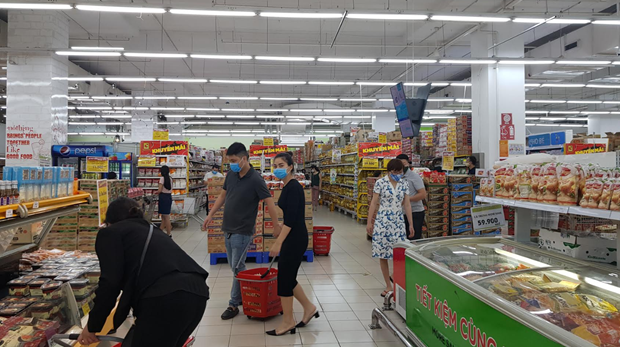Vietnam’s inflation rate stable at 3 percent: HSBC
 HSBC experts believe inflation risks have not been here to stay (Photo: VietnamPlus)
HSBC experts believe inflation risks have not been here to stay (Photo: VietnamPlus)
Hanoi (VNA) – Although Vietnam’s headline inflation rose to an eight-year high of 1.5 percent in February, it would be stable at 3 percent for the whole yaer, according to the Hong Kong Shanghai Banking Corporation (HSBC).
HSBC analysts said the hike was sparked by increased food prices and transport costs during the Lunar New Year. Furthermore, the 20 percent surge in power tariffs after the Vietnam Electricity ended its subsidy in January was billed as a locomotive for the inflation rise.
The increase in electricity prices could be a once-off administrative adjustment, HSBC said, adding competent authorities should keep a close watch on food prices and transport cost – the weighting variables in the consumer price basket, which stood at 34 percent and 10 percent, respectively in February.
Notably, without developments during Tet holiday, pork price during January-February inched up only 0.7 percent year-on-year. However, HSBC analysts said soaring global grain prices are posing upside risks.
They forecast the food prices to moderate significantly in 2021 after a 10 percent jump last year.
Higher transport costs, which is expected to shoot up 34 percent to 56 USD per barrel this year, could exert strong pressure on inflation rate.
Besides supply and demand factors, foreign exchange is also another factor that directly influences the inflation prospects.
According to HSBC, Vietnam and the US will come to an agreement on improving the VND/USD exchange rate; thus, the bank believed that the rate will continue to remain steady this year.
With all things considered, the inflation rate this year will be around 3 percent, mainly reflecting the impact of food price adjustments though rising oil prices and healthcare costs could post a threat.
“We are expecting the State Bank of Vietnam to keep its refinancing rate unchanged at 4 percent”, the bank said.
Regarding Vietnam’s GDP growth, HSBC revised downward its forecast for the country’s economic growth to 7 percent from the previous 7.6 percent.
Vietnam’s consumer price index (CPI) in February was up 1.52 percent over the previous month and 0.7 percent year on year, according to the General Statistics Office (GSO).
This is the highest February CPI growth recorded in the last eight years.
However, the index in the first two months decreased 0.14 percent year-on-year.
Compared to the previous month, an upturn was seen in the prices of ten out of 11 main groups of goods and services, with housing and construction materials taking the lead (4 percent). It was followed by food and catering services (1.61 percent); transport (1.55 percent); drinking and tobacco (0.9 percent); garment and textile, headwear and footwear (0.25 percent).
The price of education services remained stable compared to the previous month.
The GSO’s Price Statistics Department explained that the CPI in February saw a strong rise due to the higher demand for food and foodstuffs for the Lunar New Year (Tet) festival.
The prices of medicine and medical supplies in January-February increased by 0.88 percent compared to the same period last year, the price of gas in the month climbed 3.05 percent year-on-year.
There were a number of reasons for the decrease in CPI in the last two months. The petrol and oil prices decreased by 15.78 percent year-on-year while the electricity price in January fell by 16.88 percent over the same period last year, making the average electricity price in the first two months of 2021 down by 9.95 percent.
Due to the impact of the COVID-19 pandemic, the demand for travel and tourism decreased compared to the same period last year. On average, in the last two months, the air ticket price dropped by 35.65 percent, train fares down 12.39 percent; and tour prices decreased by 4.99 percent.
At the same time, domestic gold price in February was up 0.25 percent over the previous month, while that of US dollar was around 23,145 VND per USD, down 0.17 percent month-on-month and 0.76 percent year-on-year.
GSO said the core inflation in February, which is CPI excluding grain food, fresh foodstuff, energy and the State-managed medical and educational services, increased by 0.48 percent from the previous month, and 0.79 percent compared to one year ago.
The two-month core inflation grew by 0.64 percent year-on-year.
The core inflation rates in February and the first two months of 2021 compared to the same periods last year were the lowest in the past five years./.













